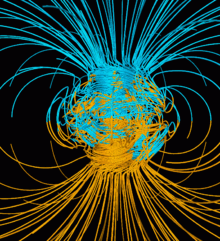
Hi Everybody!!
When you think about how far these tiny birds travel, you must be amazed as I am. We know basically why they migrate: following food. For example, when it is very cold up North, insects and flowers are more plentiful in the South. How do they know how and where to go? They are guided by the Earth's Magnetic Field. Below you will find an introduction to exactly what is the Earth's Magnetic Field as shared from Wikipedia. The photos today are the highlights from 8-25-14. Enjoy!

This male ruby-throated hummingbird is sitting in the tree next to his chosen feeder. He will stay close to this area the whole time he is here. They are constantly looking around.

The bird can intensify his red flash of the gorget at will.




The tree this bird selected is a weeping yaupon with small branches.

8-25 Photostudy Album Link:
https://plus.google.com/u/0/photos/117645114459863049265/albums/6064976578637178321

This one is a juvenile male. His throat spots will turn into the red rubies as he grows.

He is getting a couple of red spots.

He is hanging on a hanging basket of flowers.

He is getting very Fat!


https://en.wikipedia.org/wiki/Earth's_magnetic_field
Earth's magnetic field
From Wikipedia, the free encyclopedia
Earth's magnetic field, also known as the geomagnetic field, is the magnetic field that extends from the Earth's interior to where it meets the solar wind, a stream of charged particles emanating from the Sun. Its magnitude at the Earth's surface ranges from 25 to 65 microtesla (0.25 to 0.65 gauss). Roughly speaking it is the field of a magnetic dipole currently tilted at an angle of about 10 degrees with respect to Earth's rotational axis, as if there were a bar magnet placed at that angle at the center of the Earth. Unlike a bar magnet, however, Earth's magnetic field changes over time because it is generated by a geodynamo (in Earth's case, the motion of molten iron alloys in its outer core).
The North and South magnetic poles wander widely, but sufficiently slowly for ordinary compasses to remain useful for navigation. However, at irregular intervals averaging several hundred thousand years, the Earth's field reverses and the North and South Magnetic Poles relatively abruptly switch places. These reversals of the geomagnetic poles leave a record in rocks that are of value to paleomagnetists in calculating geomagnetic fields in the past. Such information in turn is helpful in studying the motions of continents and ocean floors in the process of plate tectonics.
The magnetosphere is the region above the ionosphere and extends several tens of thousands of kilometers into space, protecting the Earth from the charged particles of the solar wind and cosmic rays that would otherwise strip away the upper atmosphere, including the ozone layer that protects the Earth from harmful ultraviolet radiation.

Importance[edit]
Earth's magnetic field serves to deflect most of the solar wind, whose charged particles would otherwise strip away the ozone layer that protects the Earth from harmful ultraviolet radiation.[3]One stripping mechanism is for gas to be caught in bubbles of magnetic field, which are ripped off by solar winds.[4] Calculations of the loss of carbon dioxide from the atmosphere of Mars, resulting from scavenging of ions by the solar wind, indicate that the dissipation of the magnetic field of Mars caused a near-total loss of its atmosphere.[5][6]
The study of past magnetic field of the Earth is known as paleomagnetism.[7] The polarity of the Earth's magnetic field is recorded in igneous rocks, and reversals of the field are thus detectable as "stripes" centered on mid-ocean ridges where the sea floor is spreading, while the stability of the geomagnetic poles between reversals has allowed paleomagnetists to track the past motion of continents. Reversals also provide the basis for magnetostratigraphy, a way of dating rocks and sediments.[8] The field also magnetizes the crust, and magnetic anomalies can be used to search for deposits of metal ores.[9]
Humans have used compasses for direction finding since the 11th century A.D. and for navigation since the 12th century.[10] Although the North Magnetic Pole does shift with time, this wandering is slow enough that a simple compass remains useful for navigation. Using magnetoception various other organisms, ranging from soil bacteria to pigeons, can detect the magnetic field and use it for navigation.
Variations in the magnetic field strength have been correlated to rainfall variation within the tropics.[11]
Future[edit]
At present, the overall geomagnetic field is becoming weaker; the present strong deterioration corresponds to a 10–15% decline over the last 150 years and has accelerated in the past several years; geomagnetic intensity has declined almost continuously from a maximum 35% above the modern value achieved approximately 2,000 years ago. The rate of decrease and the current strength are within the normal range of variation, as shown by the record of past magnetic fields recorded in rocks (figure on right).
The nature of Earth's magnetic field is one of heteroscedastic fluctuation. An instantaneous measurement of it, or several measurements of it across the span of decades or centuries, are not sufficient to extrapolate an overall trend in the field strength. It has gone up and down in the past for no apparent reason. Also, noting the local intensity of the dipole field (or its fluctuation) is insufficient to characterize Earth's magnetic field as a whole, as it is not strictly a dipole field. The dipole component of Earth's field can diminish even while the total magnetic field remains the same or increases.
The Earth's magnetic north pole is drifting from northern Canada towards Siberia with a presently accelerating rate—10 kilometres (6.2 mi) per year at the beginning of the 20th century, up to 40 kilometres (25 mi) per year in 2003,[19] and since then has only accelerated.[40]
Physical origin[edit]
Main article: Dynamo theory
The Earth's magnetic field is believed to be generated by electric currents in the conductive material of its core, created by convection currents due to heat escaping from the core. However the process is complex, and computer models that reproduce some of its features have only been developed in the last few decades.
Biomagnetism[edit]
Main article: Magnetoception
Animals including birds and turtles can detect the Earth's magnetic field, and use the field to navigate during migration.[61] Cows and wild deer tend to align their bodies north-south while relaxing, but not when the animals are under high voltage power lines[clarify], leading researchers to believe magnetism is responsible.[62][63] In 2011 a group of Czech researchers reported their failed attempt to replicate the finding using different Google Earth images.[64]
(Please see link for complete interesting article as above is small excerpt)


...this is brendasue signing off from Rainbow Creek. See you next time!

O+O


No comments:
Post a Comment